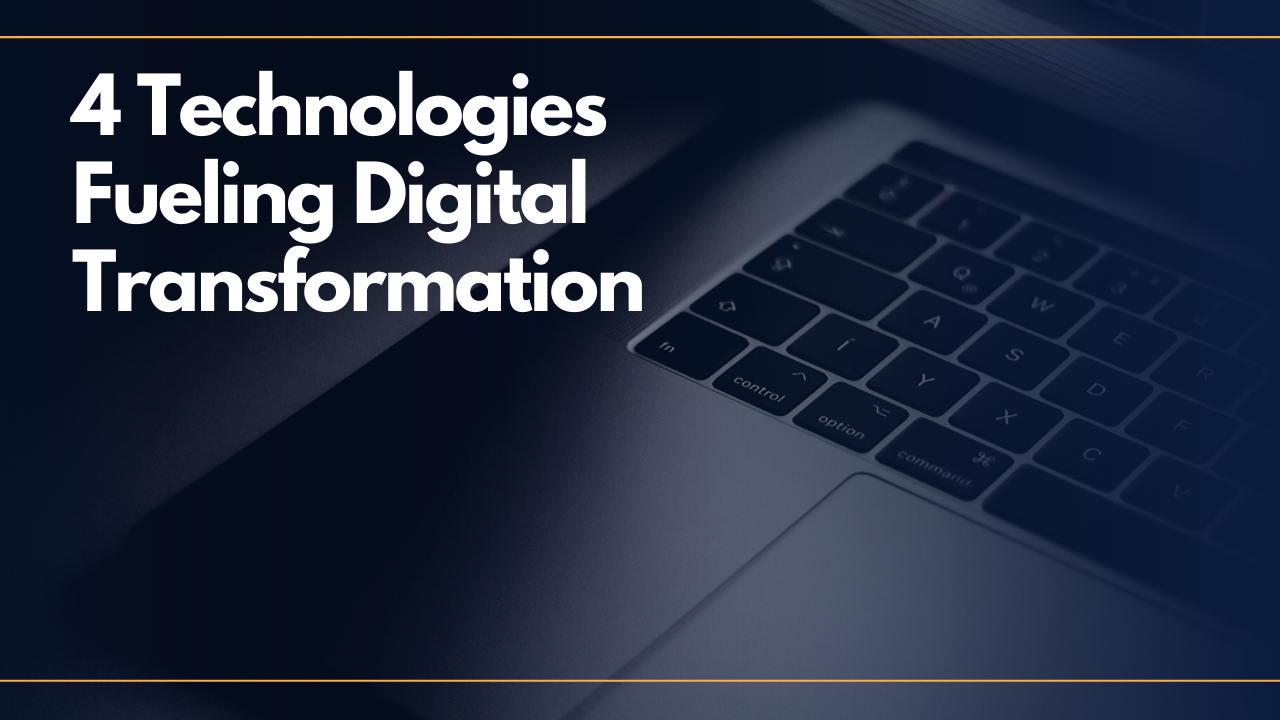- Only 44% of businesses are currently implementing a digital-first approach to business processes.
- Research estimates that the total amount spent on digitalization globally will surpass $2.1 trillion by 2021.
- Check out four of the most impactful technologies fueling this change, including: IoT and AI.
Digital transformation.
If this IT phenomenon doesn’t sound familiar, it’s likely you’re not among the 44% of businesses implementing a digital-first approach to business processes, operations, and customer engagements.
As Citrix defines it, “Digital transformation is the strategic adoption of digital technologies. It’s used to improve processes and productivity, deliver better customer and employee experiences, manage business risk, and control costs.”
It’s no secret technology has been a driving force in business transformation for years, but new technologies are now launching faster than ever.
Suggested Reading: “Future of Work: 70% of Digital Transformation Efforts Are Failing – Here’s Why”
In order for today’s businesses to deploy efficient processes, deliver superior customer experiences, and maintain engaged workforces, it’s vital to stay up-to-date on the emerging technologies that enable these capabilities. With that said, the International Data Corporation anticipates the total amount spent on digitalization globally will surpass $2.1 trillion by 2021.
With digital transformation expected to be an important strategy for all types of businesses in 2020, here are four of the most impactful technologies fueling this change.
Cloud Computing
Chances are you’ve heard of the cloud by now, or even used the term yourself, but haven’t realized the impact it has on day-to-day activities. If you’ve edited a document in Google Drive, streamed music on Spotify, or updated your resume on LinkedIn, you’ve seen cloud computing in action, though you may not have been aware of it.
Cloud technology is very beneficial for businesses, especially where collaboration is concerned.
As new working styles like flexible hours and telecommuting become more popular, cloud-based tools enable simple and efficient employee collaboration. Business applications built to run on the cloud offer a complete, connected, and integrated method to streamline lines of business including finance, supply chain, and human resources.
However, be wary of business solutions such as SAP’s HCM suite or Infor ERP products, which are at various stages of cloud readiness. This may instead make it more difficult to collaborate between departments, as their applications don’t work as a cohesive suite.
Internet of Things (IoT)
The Internet of Things (IoT) is accomplishing more than simply establishing connections between devices and systems. In fact, it’s opening up opportunities for creating previously unattainable new products and services.
According to a recent Forbes Insights survey, 63% of today’s enterprises have used their IoT capabilities to deliver new or updated services directly to customers.
IoT tools can discover, capture, and act on the various data sources now available from an array of devices, sensors, and systems around the globe. Organizations using the IoT will have an in-depth view of their customers’ requirements in a way that wasn’t previously possible and can then use those insights to improve the customer experience.
One area in which IoT will play an important role in 2020 is in healthcare products and services.
For example, many “smart” hospitals are using IoT devices for remote patient monitoring through wearables and health sensors. Integrated monitoring systems can now track patients, staff, and equipment like an indoor GPS. This both maximizes resources and saves money, while also streamlining processes for professionals in this industry.
Artificial Intelligence (AI)
Artificial intelligence (AI) has quickly become a popular application for many businesses because of its focus on making intelligent machines that are capable of solving some problems as well as (or better than) people can.
More and more companies have developed AI-based applications, which have lowered costs and made AI accessible to both small and enterprise-level organizations. Gartner reports AI adoption has tripled in the last year alone, with an estimated 37% of organizations now implementing AI in some form.
AI-based tools and technologies can help today’s workforces become more productive and efficient, while also yielding a more positive customer experience. Take AI-fueled chatbots for example, which can respond to customer queries, automate tedious tasks, and facilitate the sales experience for customers.
Suggested Reading: “Future of Work: AI Is Reshaping Managers’ Traditional Role”
One of the key benefits of chatbots is they know, through machine learning and AI, when to bring an actual human into the conversation with a consumer. Take for example Roof Ai, a chatbot built for real estate agents that automates lead interactions and lead assignments via social media. This chatbot makes recommendations for real estate listings to users, and once they gain interest, passes them on to the actual human agent managing the property.
Voice Technology
Thanks to the growing popularity of devices like the Amazon Echo and Google Home, voice capabilities have also begun to add value in customer experience, with eMarketer predicting 31 million people in the US will have shopped via a smart speaker by the end of 2019.
Purchasing experiences equipped with voice capabilities can serve as a useful tool to the customer as it leverages data and audio feedback to make a customer’s task easier or more seamless. In return, customers offer these brands greater loyalty and repeat business.
According to data from research firm Consumer Research Intelligence Partners, consumers that use their Echo to make purchases are among Amazon’s most loyal customers, spending an average of $1,600 per year compared to the $1,300 per-year average of Prime customers, a figure 66% higher than the average Amazon customer spends in a year.
In order to consistently deliver positive customer experiences, business-to-consumer-style businesses must learn to adapt voice technologies.
These are just a few examples of emerging technologies fueling the digital transformation—each one allows businesses to think differently about how they use today’s available technology, allowing room for change and innovation. Be sure to continuously evaluate and review these technologies in order to use them to your best ability.


 Dr. Gleb Tsipursky – The Office Whisperer
Dr. Gleb Tsipursky – The Office Whisperer Nirit Cohen – WorkFutures
Nirit Cohen – WorkFutures Angela Howard – Culture Expert
Angela Howard – Culture Expert Drew Jones – Design & Innovation
Drew Jones – Design & Innovation Jonathan Price – CRE & Flex Expert
Jonathan Price – CRE & Flex Expert














